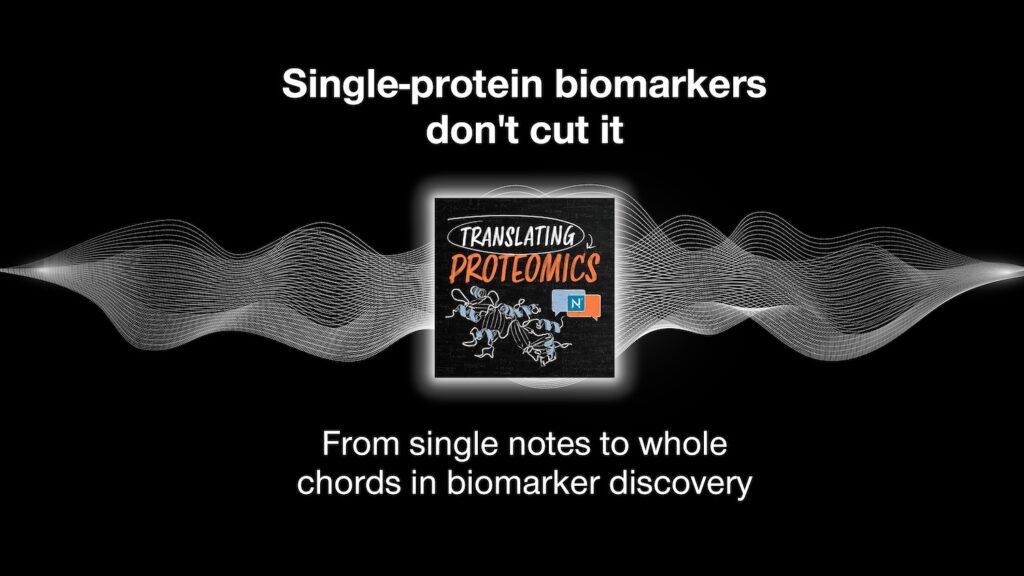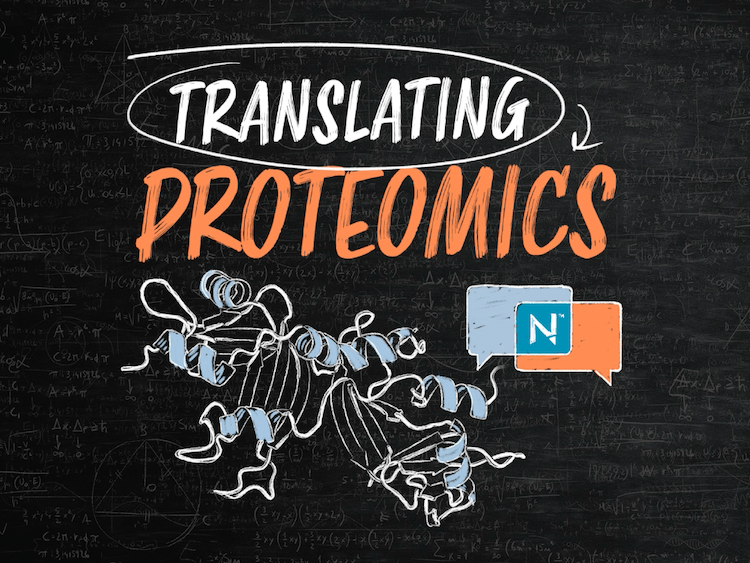
Why single-protein biomarkers don’t cut it – From single notes to whole chords in biomarker discovery
Nautilus Biotechnology
November 12, 2024

Modern biological research often depends on discovering disease biomarkers. Biomarkers can help diagnose disease, reveal whether a treatment works, and offer real-time patient health information.
Finding reliable protein biomarkers has been a consistent challenge — of tens of thousands of potential biomarkers identified in studies, just a tiny percentage are FDA-approved for use in the clinic. Biomarker discovery can be accelerated with the use of novel technologies that make it more feasible to mine the proteome, but that doesn’t mean it’s an easy task.
On the fourth episode of Nautilus’ Translating Proteomics podcast, Nautilus Co-Founder Parag Mallick talks with Senior Director of Scientific Affairs and Alliance Management Andreas Huhmer about the complexities of finding effective biomarkers. They make a compelling case that moving beyond single-protein biomarkers may make the biomarker discovery process more successful. In addition, they argue that new technologies are needed to identify hard-to-find proteins, measure them repeatedly across time, and bring more biomarkers into the clinic.
Why are protein biomarkers so hard to find?
On the podcast, Parag and Andreas divide opinions on the challenge of biomarker discovery into two main camps. One camp suggests protein biomarkers are simply rare, requiring highly sensitive detection methods. The other argues that we’re looking for protein biomarkers in the wrong ways and places. From this perspective, biomarkers aren’t actually rare, they just appear to be based on our current practices.
Both Parag and Andreas tend toward the latter camp. Parag notes that our current methodologies may be insufficient for finding robust protein biomarkers and advocates for more comprehensive and proactive discovery and sampling methods.
“We need to change the way we think about biomarker studies and the ways that we sample people,” he says. Studies that take just one sample from patients can glimpse only a single time point. In dynamic biological systems, that may not be enough to find protein biomarkers reliably.
Parag notes that we really need to think about timescales when looking for different kinds of biomarkers. “We know that there are metabolites that are gone within seconds of taking blood out of the body,” he says. Likewise, leaving a tissue sample on a gauze pad can result in significant biological changes that mask the biomarker signal.
In addition to that challenge, the tools we use to find biomarkers aren’t always as powerful as we need them to be.
“We have to have super sensitive tools to find biomarkers,” Andreas says. This sensitivity is crucial because biomarkers, particularly in blood, exist in low concentrations amidst a complex mixture of proteins, metabolites, and other biological molecules.
Watch Parag and Andreas discuss what biomarkers are and why they’re so hard to find.
The need for a new protein biomarker paradigm
Shifting away from single-time-point biomarkers, which contain only an isolated piece of information, is another key paradigm shift to advance the field. Parag likens it to trying to guess a song based on musical notes.
“If I played you one note on a synthesizer and asked you to name the song, it would be virtually impossible,” he says. “We absolutely need to get to a world where not only are we measuring one note at one time, but we’re measuring chords across time.”
For that, we need technologies capable of making repeated measurements easily across time to see the true role each potential biomarker plays. We may also need to move away from population averages. “That way, we have a baseline for each person [and] we get routine sampling of them,” Parag says, pointing to the Veterans Administration’s regular sampling as a powerful model.
This is proactive sampling as opposed to reactive sampling, and it can be achieved using broadscale proteomics (also known as discovery proteomics) techniques that scan proteomes using highly sensitive proteomics platforms. Such techniques and technologies could help us put together the “chords” of biomarker activity that accurately report on biological processes.
Another important change to the paradigm involves cataloging and storing biomarker data. We must standardize our data warehousing practices to ensure that biomarker data is accessible and usable across different research domains. “When we do a biomarker study, are we depositing it in a shared resource where other people can leverage it?” Parag asks.
Watch Parag and Andreas discuss shifting the biomarker paradigm.
Understanding how protein biomarkers differ
To find better biomarkers, it’s also crucial to understand that different biomarkers exhibit distinct properties. Cataloging these and developing a better understanding of basic biomarker biology are necessary steps to finding better biomarkers.
For instance, when testing for cancer, a biomarker with a long persistence time in the body might be ideal, Parag says. This type of biomarker accumulates over time, providing a clear indication of tumor growth. On the other hand, when assessing how a patient responds to a drug, a biomarker with rapid kinetics is more desirable. Such biomarkers can quickly reflect the therapeutic effects, allowing for timely adjustments in treatment.
Still, some basic questions about biomarkers are tough to answer, Parag says. “How did that protein get into the blood? How big did the tumor have to be to see how much of that protein is in the blood?”
Understanding the biological context of a given protein biomarker shows what it does and why it’s relevant to a given disease or state. Knowing these key facts is crucial to turning biomarkers into functioning tools to better human health.
Watch Parag and Andreas discuss the need to understand the basic biology of biomarkers.
Embracing proteoforms for biomarker discovery
A final advancement in biomarker discovery could come from examining proteoforms — the functional forms of single protein molecules with their accompanying modifications. Proteoforms studies provide a more nuanced understanding of protein function and disease mechanism, making them valuable targets for biomarker discovery, Andreas says.
“Capturing the various active forms of proteins ultimately will be the place where you find really relevant biomarkers,” he says.
Next-generation proteomics platforms for enhanced biomarker discovery
In summary, to create a world filled with more, and more robust, biomarkers, we need to move beyond single protein measurements, beyond gathering samples from patients just once, and toward a better understanding of the basic biology of biomarkers.
The technologies we use to find biomarkers, including the proteomics tools that hunt for new proteins of interest will be a major part of these advances. Thus it is crucial that we develop tools that are faster, more sensitive, and capable of handling the complexity of biological samples. While current proteomics tools may not extend far enough, technologies on the horizon may vastly enhance biomarker discovery.
We are designing the Nautilus Proteome Analysis Platform to be one such technology. Learn more about the capabilities we’re designing into the platform here.
Check out our episode of Translating Proteomics focused on plasma proteomics to learn how plasma proteomics techniques impact biomarker discovery.
MORE ARTICLES

